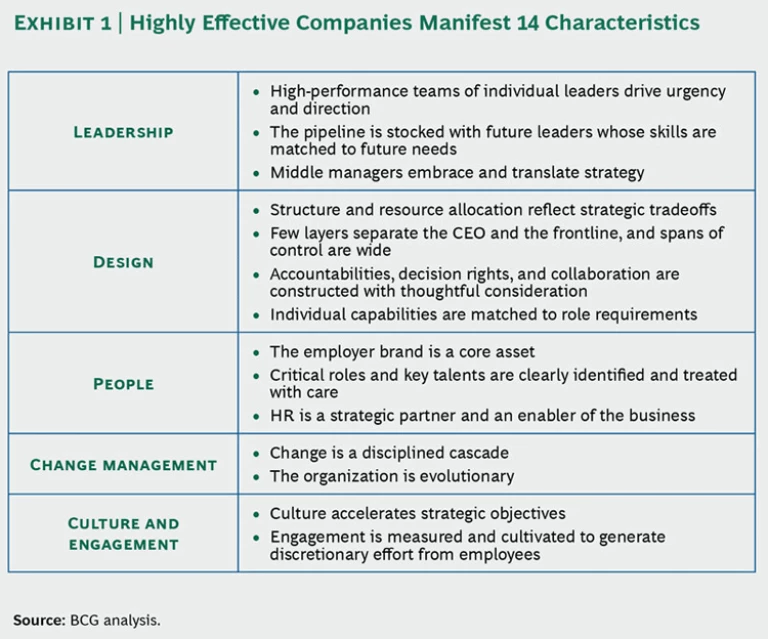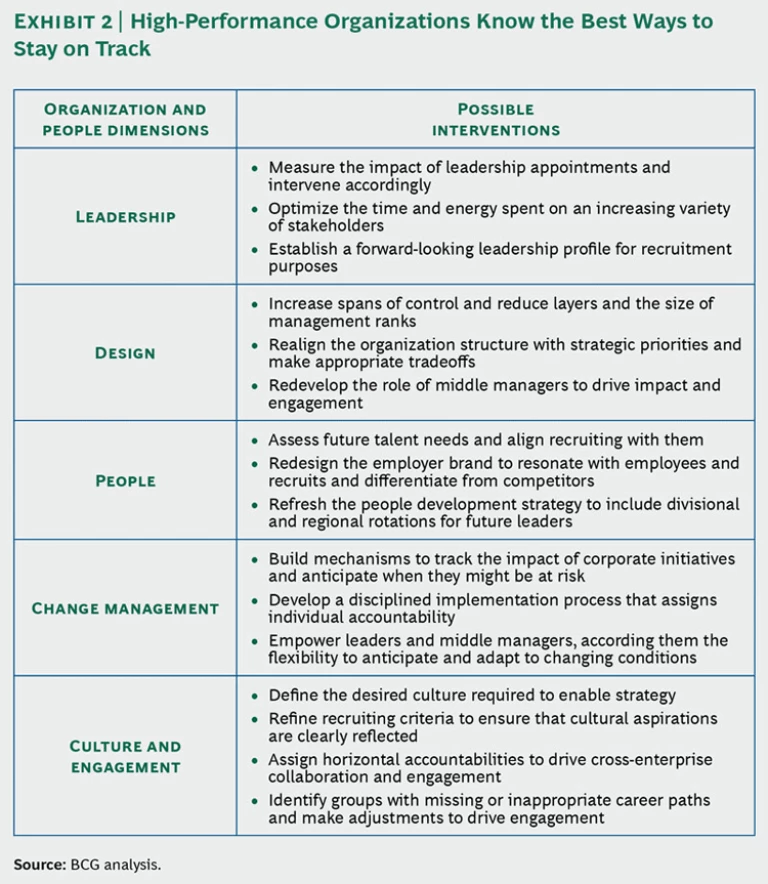When you walk into a high-performance organization, you can feel the difference. Instead of just going through the motions, the people are energized. They are confident about their organization’s strategy and the changes that are occurring, rather than confused or resigned. They know what they are supposed to be doing and how that relates to the tasks of their neighbors. Your casual observations can be confirmed quickly by checking performance measures such as sustained earnings and market share growth at corporations and, in the nonprofit world, social impact.
But how do organizations become high-performance organizations? We all know intuitively that organizational and people capabilities drive financial and operational performance and enable companies to execute their strategy, but most companies do not know how to measure these capabilities or what steps to take to improve them. Executives have well-developed tools for financial and operational performance but not for driving organizational and people capabilities.
In order to fill this gap, we have compiled a list of 14 organizational and people characteristics that can be grouped into five broad dimensions and that lead to sustained performance.
- Leadership. An aligned leadership is effective deep within the organization.
- Design. A lean structure reflects the organization’s strategic focus and has clear roles and accountabilities.
- People. The organization effectively translates business strategy into a powerful people strategy, attracting and retaining the most capable individuals.
- Change Management. The organization has the ability to drive and sustain large-scale change and to anticipate and adapt to an increasingly volatile environment.
- Culture and Engagement. The culture is shaped to achieve strategic goals, and its employees are motivated to go beyond the call of duty in pursuit of corporate objectives.
When organizations take a strategic approach to their pursuit of monitoring and improving these five broad capabilities—and the 14 characteristics they represent—they generate lasting performance gains and a competitive edge. (See Exhibit 1.)
Tolstoy was right: each unhappy family is unhappy in its own way, but all happy families—or high-performance organizations—are alike. By understanding the common strands of organizational DNA, all companies can put themselves in a stronger position to achieve success. (See “Optimizing People and the Organization at the Royal Bank of Canada,” below.)
Optimizing People and the Organization at the Royal Bank of Canada
The Royal Bank of Canada (RBC)—Canada’s largest bank—had experienced a significant drop in financial performance. By 2004, after ten years of top-quartile performance, shareholder returns had fallen to the fourth quartile. Through careful analysis and by talking with employees from the frontline through senior management, CEO Gordon Nixon recognized that fixing organizational and people issues would be critical for improving financial performance and competitive advantage.
Collaboration was poor across businesses. The executive team’s decision-making disciplines had slackened—decisions were made slowly and without consistent analysis and transparency. And the organization structure, which was costly, was also leading to low levels of employee engagement.
The senior leadership team created a comprehensive transformation program that addressed operations, culture, and structure. The bank’s management ranks were restructured, and initiatives that focused on revenue growth and cost reduction were put in place. To ensure the success of these initiatives, each leadership layer created its own role charters, so performance expectations and accountabilities were clearly laid out.
The senior team clarified its expectations for leadership behaviors and revised the performance management system to reward achievement of financial targets and agreed-upon behaviors (such as welcoming challenge, being solution oriented, and taking an enterprise-wide instead of a siloed perspective). To keep the effort on track, the bank rigorously managed the three-year transformation by establishing clear targets and accountabilities.
The plan worked. Three years after the completion of the transformation in 2007, RBC’s stock price had doubled, far outstripping the gains of its peers. In subsequent surveys, most employees agreed that the daily activities of the bank and its employees reflected the vision of the transformation and that leaders were behaving in accordance with the new values. RBC continues to monitor its performance across the five organization and people dimensions and takes action when performance or the competitive environment changes.
Leadership
Leadership is a scarce resource, both in developed markets suffering from an exodus of older executives and developing markets straining to keep up with rapid growth. Today’s accelerated pace of change has weakened leadership conducted solely through command and control. Effective leaders think strategically, set the pace, allocate resources, build engagement, drive accountability, and deliver results. No easy set of tricks in good—let alone uncertain—times. Leadership starts but does not stop at the top of the pyramid. High-performance organizations create leaders at every level through three primary levers.
High-performance teams of leaders drive urgency and direction. Leaders are comfortable with complexity, volatility, and change. In the face of ambiguity, they are able to mobilize the organization. Although leaders need to be visionary, they cannot be lone wolves or independent operators; the days of the heroic corporate leader are over. Today’s leaders need to work cooperatively with their peers and recognize the collective strength generated through collaboration. Increasingly, they must be comfortable dealing with outsiders such as nongovernmental organizations, regulators, and other bodies that are now participating more actively in business.
The pipeline is stocked with future leaders whose skills are matched to future needs. High-performance organizations have leaders in the wings who have been rotated through many types of positions and roles in many functions and regions and are groomed for success. These organizations identify potential leaders early in their careers—and cultivate in them the skills and competencies that will be required in the future. (High-performance companies fill 60 percent of top-management roles with internal candidates, while low-performance companies fill only 13 percent internally, according to a survey of more than 5,000 executives conducted by The Boston Consulting Group and the World Federation of People Management Associations.)
Middle managers embrace and translate strategy. Middle managers oversee the vast majority of employees, translating the strategy and vision endorsed by senior leaders into concrete plans for their teams. They also select and elevate the key issues from the frontline that need senior management’s attention. Despite the pivotal and difficult role middle managers play, they often get lost in the shuffle and receive insufficient development, support, and attention from senior leadership. Senior executives consistently receive higher engagement scores than middle managers in BCG’s Engaging for Results survey. Leading organizations recognize the importance of middle managers, invest in their success, and actively monitor and work to strengthen their engagement and skills.
Design
Organization design can help companies improve execution and achieve strategic goals. But for that to happen, the interplay among its key elements—structure, individual capabilities, and roles and collaboration—must be carefully coordinated and tightly linked with a company’s strategy and sources of competitive advantage.
Structure and resource allocation reflect strategic tradeoffs. Compromise is inherent in organization design. A well-designed structure should emphasize what matters most to an organization. In the real world, it is impossible to accommodate all dimensions equally. A company focusing on future performance in key markets, for example, might organize businesses by region rather than channels. Its executives would, then, need to take careful steps to ensure that channels were receiving proper support even though they did not form the dominant axis in the organization. An organization’s structure should also be dynamic, oriented around current and future—rather than legacy—priorities. When strategy, performance, or the competitive environment changes, an organization’s structure may need adjustment.
Few layers separate the CEO and the frontline, and spans of control are wide. Lean structures allow organizations to focus on meaningful work, rather than coordination. Activities that don’t deliver value are eliminated. With fewer organizational layers, communication and decision making are faster, and senior leaders have a better view of day-to-day operations and customer interactions. With wider spans of control, managers become more ambitious in applying their leadership skills. They don’t have time to micromanage but can grow comfortable in their ability to lead, coach, and inspire. (Context matters: wide in R&D would be narrow on the shop floor.) Although lean organizations also have a lower cost base, the other effectiveness benefits are actually greater than the financial ones.
Accountabilities, decision rights, and collaboration are constructed with thoughtful consideration. High-performance organizations have clearly defined roles that are carefully assembled to form a highly efficient organization. People understand what is expected of them and which decisions are theirs to make. When accountability is shared, employees understand clearly when and with whom they need to collaborate. We help companies achieve this clarity through role charters, but what they are called is less important than the need to have a path to achieve clear accountabilities, decision rights, and behavioral expectations. Clear roles remove the ambiguity that slows decision making and improve the performance potential and employee engagement of modern organizations. Role charters enable honest conversation among an organization’s peers about individual, collective, and shared responsibilities. (See “The Power of a Charter,” below.)
The Power of a Charter
Role charters work. At a financial services company, one business unit used role charters to delayer the organization and increase spans of control, while another business unit implemented a traditional head-count reduction. In subsequent surveys, the employees of the business unit that relied on charters reported better morale and a better understanding of the initiative’s strategic intent than did the employees of the other business unit.
Role charters are not job descriptions. Employees participate in the drafting of their role charters, which focus on accountabilities and decision making, rather than their detailed activities. Role charters are not static; they can be refreshed regularly to reflect changing strategic priorities.
Individual capabilities are matched to role requirements. Roles need to be staffed by the right people with the right skills. Depending on its needs, for example, a company might require a head of sales who is a great “closer” and can excite the sales force. Or it might need a solid manager who can implement a new sales-management system. Unless the broader organizational needs are explicit, managers may hire and promote people on the basis of their perception of “fit.”
In filling positions, it can be helpful to consider whether a role requires a change agent, domain expert, or safe pair of hands. Leading companies ensure that they have a balance of these capabilities across the organization and recognize that their needs for particular roles will change over time. As a role’s needs change, the fit of the people who inhabit that role should be reassessed. Too often, companies lack this pragmatism.
People
While many companies boast particular strengths in recruiting, training, or performance management, high-performance organizations are effective at translating their business strategy into a compelling people strategy. At these organizations, the HR function acts as a strong advisor to business units on both operational and strategic people issues. It has short- and long-term plans for identifying, attracting, developing, and retaining the right people with the right capabilities.
The employer brand is a core asset. High-performance organizations have a well-defined employer brand. Employees and recruits alike know the broad range of benefits—beyond compensation—that employees enjoy, ranging from career advancement, job rotation, and prestige, to flexibility and autonomy. This brand—or employee value proposition—contributes to an organization’s strengths and competitive edge.
High-performance organizations invest in employee development through training and by rotating people through roles and responsibilities. These experiences are a powerful motivational and retention tool that can trump compensation and other financial incentives. They also encourage collaboration and reduce the likelihood of parochial leadership behavior. By the time employees reach the top ranks, they have a broad view of the organization.
The flip side of talent management is the management of poor performers. The way an organization handles the development or departure of low-performance employees sends a powerful signal to the rest of the organization about what will be tolerated and what will be celebrated.
Critical roles and key talents are clearly identified and treated with care. Talent management is a broader activity than most organizations realize in practice. It is not just reserved for those on the fast track. It also covers the people and roles critical to enterprise success. Relationship managers at a financial brokerage and the diagnostic testers in a medical laboratory, for example, need to be treated as valued talent, even though they may never be in future leadership roles. High-performance organizations identify these critical roles and individuals and focus retention strategies and contingency plans around them. This list of individuals and roles should be dynamic, changing with the firm’s strategic priorities.
HR is a strategic partner and an enabler of the business. In leading organizations, people strategy is as prominent as business strategy. The HR function has successfully translated business strategy into people objectives and enabled business priorities through people initiatives. The function operates with clear separation of strategic, functional, and transactional activities. It efficiently completes functional and transactional activities and effectively influences strategic topics. To perform these varied roles and become a strategic partner many companies may need to adjust the capabilities of their HR function to be able to provide line managers with analytics and advice. (See “Google’s Rule of Three Thirds,” below.)
Google’s Rule of Three Thirds
Google’s HR function has established credibility by having a clear understanding of the company’s functional, strategic, and analytic HR needs and by ensuring that the department is staffed accordingly, says Laszlo Bock, vice president of people operations at Google. “If you compare [HR] to supply chain management, marketing, sales, or operations, there has not been as much rigor historically,” Bock says. “In part, that is why the HR function has had a hard time getting a seat at the table.”
Bock deliberately set out to hire staff with the skills that would allow the department to play both operational and strategic roles. “One-third of the people come from traditional HR backgrounds. They’re outstanding HR generalists and outstanding compensation-and-benefits folks,” Bock says.
The second third comes from strategy consulting firms. “We are looking for two things: great problem-solving skills—the ability to take a really messy problem, disaggregate it, and drive to data-driven answers—and really deep business sense, a deep understanding of how business actually works in the different functions.”
This blend of specialists and generalists helps create powerful cross-pollination. “The HR folks learn a tremendous amount about business and problem solving from the consultants, and the consultants get very quickly up to speed on the pattern recognition you need to be successful on the people side,” Bock says.
The final third, according to Bock, “are people with advanced degrees in various analytic fields—PhDs and master’s degrees in operations, physics, statistics, and psychology. They let us run all kinds of interesting experiments and raise the bar on everything we do.”
Change Management
In today’s fast-paced world, the ability to change in two fundamental ways generates sustained competitive advantage. First, companies need to have a disciplined approach to drive shifts in focus, strategy, direction, structure, and culture. Second, they need to have the ability to adapt to rapidly changing developments in the market.
Change is a disciplined cascade. Despite the high rate of failure among change programs, a few organizations are beating the odds. They ensure that the leadership group is aligned on the goals and means of change, and they deliberately transfer that alignment to employees layer by layer throughout the organization. During a major change, senior executives receive feedback from deep within the organization, where the fate of change resides, in order to track progress and make adjustments.
We call this process cascading change. By keeping their focus on the most important elements of cascading change, companies achieve minimum sufficiency: doing enough to succeed without unnecessarily fragmenting focus and effort.
Organizations that do this also rely on hard and soft strategies to deliver change. They define accountabilities and metrics for individuals and give them the tools and authority to succeed at implementation. They track their progress against important milestones, know when initiatives are at risk of falling behind schedule, and take corrective action. They also communicate and engage with key stakeholders in order to maintain confidence and commitment during turbulent times. A study of BCG’s database of change programs indicates that organizations following this approach exceed their financial targets. (See “Change Starts at the Top,” below.)
Changes Start at the Top
A global pharmaceutical company recently used a change cascade to generate more than $1 billion in earnings improvement in the face of large regulatory, legal, and competitive challenges. The restructuring required the total commitment and participation of senior executives.
One executive-committee member relinquished substantial day-to-day responsibilities, devoting well over half his time to orchestrating the change cascade. The rest of the senior leaders participated in cross-functional teams responsible for delivering concrete results. The senior leaders used so-called belief audits and other tools to uncover points of agreement, misunderstanding, and misalignment.
They delayed starting projects until they had alignment, used contracts and charters to crystallize agreements, and relied on program management techniques to create transparency and measure results. This discipline about alignment, goals, and progress spread easily throughout the organization.
The organization is evolutionary. High-performance organizations are adaptive, continually detecting changes in the market and making strategic adjustments. This approach supplements rather than replaces the broad strokes of classic strategy. They empower the periphery of their organizations—far away from the classic strategy function—to spring into action in anticipation of market developments.
Culture and Engagement
Culture is the way things get done in an organization and reflects employees’ behaviors and attitudes toward work. It is the “secret sauce” of an organization, bringing a strategy to life or deadening it. Culture is not fixed. It is possible—and necessary—to cultivate a specific culture. Employee engagement, meanwhile, is the willingness of employees to go the extra mile for an organization, not merely out of obligation or for a paycheck but because work matters both personally and professionally to them.
Culture and engagement are different from leadership, design, people, and change management: culture and engagement are products of the 12 other characteristics. Organizations improve culture and engagement indirectly by working on the other characteristics in the same way that people exercise their hearts by exerting other body muscles. For example, performance management systems, an element of the people dimension, can have a powerful impact on culture.
Culture accelerates strategic objectives. Good corporate culture is not accidental. High-performance organizations set, manage, and monitor culture to achieve strategic objectives. A culture that features risk aversion, process, and clear lines of command may be eminently reasonable for an air carrier, but it’s a recipe for weak performance in an Internet company. A culture either works for a given enterprise—or it doesn’t—at a point of time. As strategic priorities change, so should culture. (See “Merging Cultures,” below.)
Merging Cultures
In the process of their recent merger, two European banks needed to combine two very different business models and cultures. One bank was skilled in direct sales, while the other focused on traditional branch banking. The merger’s success hinged on the ability to integrate the two cultures.
Senior leaders first needed to agree on the key desired behaviors of the new organization and their consistency with core values. The organization’s top three levels met quarterly to ensure that they were in alignment and to track the progress of the transformation. In order to cascade these behaviors beyond senior management, the bank tailored training to the specific challenges of each level of the organization and developed tool kits to help convey each core value.
To ensure that the changes would take root, the bank built behavioral expectations into performance reviews. Since the merger, it has tracked both employee engagement and customer attrition, and scores in both domains have been strong. The bank is also ahead of schedule in reaching its financial and head-count targets.
Engagement is measured and cultivated to generate discretionary effort from employees. At a high level, engagement is built through two equally important dimensions: personal motivators, such as recognition, and performance disciplines, such as performance management metrics. High-performance organizations keep a finger on the pulse of their people, regularly measuring engagement levels and actively managing engagement through difficult times, such as a reorganization or large-scale change effort. (See “Taking Flight,” below.)
Taking Flight
The newly minted CEO of a global transport company faced significant challenges centered on employee engagement. The business had recently gone through a protracted labor dispute with its engineers, and other employee groups were also disaffected. The CEO knew that long-term business success hinged on improving employee engagement. To establish a base line, the company conducted an engagement survey, first with its top several-hundred managers and then with all employees. The survey showed that although employees had pride in the company, overall engagement was low. Realizing that improving engagement would require strong and united leadership, the CEO initially concentrated on uniting his top leaders before expanding the focus to middle managers.
The CEO sharpened and explained the company’s strategy, which helped clarify the organization’s objectives and aspirations for employees. He reduced the number of layers and improved spans of control. The executive team collectively established role charters in order to improve and clarify accountabilities. Each senior executive then oversaw the creation of role charters for his or her direct reports.
For the first time, leadership behavior became a major component of the evaluation process. The company also invested in coaching, leadership, and mentoring skills for senior and middle managers. These leaders became accountable for raising engagement scores in their parts of the organization, and they all have targets to reach within four years.
The early returns suggest that the focus on engagement is paying dividends. Levels of accountability and engagement have already significantly increased at senior and upper-middle-manager levels, and positive behaviors are taking root.
Companies often make changes to their organization and people elements in knee-jerk response to external events, adding people in heady times, cutting staff during slack periods, and then providing leadership training when morale inevitably falters and the organization suffers whiplash reactions to shifts. Others take a laissez-faire approach, with few deliberate initiatives. Neither of these approaches yields sustained performance records.
High-performance organizations just work differently. They understand the need to have all 14 characteristics present in their organization and take a coordinated approach to implementing them. They also decide which of the 14 are the most critical to sustained competitive advantage and actively work to improve weak spots by engaging in a disciplined set of interventions and activities. (See Exhibit 2.)
Furthermore, these organizations closely monitor and measure their adherence to these characteristics with the same intensity and skill they require of themselves for financial and operational performance.
The pursuit of the right organizational and people characteristics is no longer an undefined black box. Just as the development of MRI technology provided physicians with a previously unavailable visual image of organs and musculature, this framework gives companies a window into internal dynamics that have been only vaguely understood, and access to this knowledge can lead to sustained performance.







